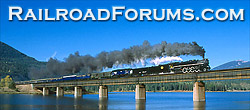Railroadforums.com is a free online
Railroad Discussion Forum and
Railroad Photo Gallery for railroaders, railfans, model railroaders and anyone else who is interested in railroads. We cover a wide variety of topics, including freight trains, passenger and commuter railroads, rail news and information, tourist railroads, railway museums and railroad history.
Sitting in a display case in our lounge is a model made by my late father-in-law in O-Gauge of a Midland railway Railmotor from the early 20th century. David painted the model in LMS livery. Its presence in our lounge has been an encouragement to find out more about steam powered railcars.
The linked article is the first of at least 6 articles about steam railcars.
http://rogerfarnworth.com/2024/06/11/steam-railcars-part-1-an-early-example/
This second article about Steam Railcars focusses on two early proponents of the units ...Dugald Drummond and Harry Wainwright. .....
“Drummond was born in Ardrossan, Ayrshire on 1st January 1840. His father was permanent way inspector for the Bowling Railway. Drummond was apprenticed to Forest & Barr of Glasgow gaining…

rogerfarnworth.com
A third article about UK Steam Railcars/Railmotors. This article focusses on the Great Western Railway. ....
After borrowing a LSWR railmotor/railcar in the early years of the 20th century and running trials between Stroud, Chalford and Stonehouse on the ‘Golden Valley Line’, the GWR embraced …

rogerfarnworth.com
This fifth article about Steam Railcars/Railmotors focusses on articulated steam railmotors in the first two decades of the 20th century. ...
Earlier articles in this short series about steam railmotors can be found on these links: The Earliest Steam Railmotors: Dugald Drummond and Harry Wainwright: The GWR Steam Railmotors: Rigid-bodied…

rogerfarnworth.com
We will look at steam railmotors which served during the era of the big four companies after grouping in the next article.
The new companies which came into existence with the grouping in 1923 addressed once again the best way to serve lightly populated rural communities. The options available to them centred on various forms of light railcars. Two forms of propulsion were available, the internal combustion engine and the steam engine. Electricity, in many cases required too large an investment for the likely traffic on the intermediate routes in rural areas.
Steam railcars/railmotors surprisingly given early experiences, had a second opportunity to serve in the era of the big four!
http://rogerfarnworth.com/2024/06/26/steam-railmotors-part-6-after-the-grouping/
Affiliate Disclosure: We may receive a commision from some of the links and ads shown on this website
(Learn More Here)




